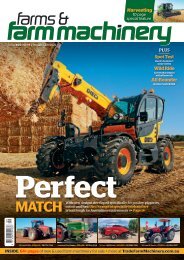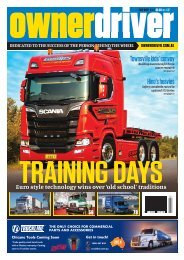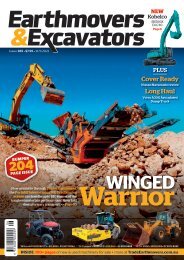Owner/Driver #339
Create successful ePaper yourself
Turn your PDF publications into a flip-book with our unique Google optimized e-Paper software.
DIABETES NSW & ACT Katie Allison<br />
Facts about fibre<br />
Did you know there is more to fibre than just<br />
healthy bowels? Here are some easy-to-swallow tips<br />
FIBRE RICH FOODS can help lower<br />
cholesterol levels and help prevent<br />
or manage type 2 diabetes. In<br />
addition, high fibre foods promote<br />
the feeling of fullness and can<br />
assist with weight loss. Fibre is<br />
also a marker for nutrition as it is<br />
often found in foods higher in vitamins<br />
and minerals. For these reasons it is<br />
important to ensure we are meeting our<br />
fibre target through eating whole foods<br />
naturally high in fibre rather than relying<br />
on supplements.<br />
It is generally recommended that<br />
adults aim for at least 25-30* grams of<br />
fibre each day. Rich sources of fibre<br />
include wholegrain varieties of bread,<br />
cereal, pasta, rice, fruit, vegetables, nuts,<br />
seeds, legumes and pulses.<br />
Fibre is famous for its positive<br />
effects on digestive and bowel health.<br />
Constipation can be a common problem,<br />
especially as we get older. A combination<br />
of slowly increasing dietary fibre,<br />
drinking plenty of water and regular<br />
physical activity may help relieve<br />
constipation.<br />
How to get closer to your 25-30*<br />
grams per day<br />
Choose wholegrain bread over white<br />
bread. Look for:<br />
• Breads that list ‘wholegrain’ or<br />
‘wholemeal’ first in the ingredient list<br />
• Breads with a high content of oat bran<br />
or barley<br />
• Breads that have 5g dietary fibre<br />
or more per 100g (you will find<br />
this information on the ‘Nutrition<br />
Information’ panel usually on the side<br />
of the loaf)<br />
• The more grains and seeds the better!<br />
Stack on the veggies or salad<br />
Always add a side salad or veggies to<br />
your meal; this will also help fill you<br />
up. An easy way to get more veggies in<br />
your diet is to buy a packet of frozen<br />
vegetables that steam in a microwave in<br />
only minutes. It’s easy and nutritious,<br />
and perfect if you are on the road and<br />
can only stop at the local servo for a<br />
frozen meal.<br />
Veggie sticks can be an easy way to<br />
boost your fibre but have little effect on<br />
your waistline. Add a little hummus or<br />
salsa for flavour.<br />
Food safety is always key so it is well<br />
worth investing in a small esky or<br />
insulated lunch back and ice brick.<br />
Love your legumes<br />
Legumes such as baked beans, chickpeas<br />
and lentils are full of fibre and soak up<br />
flavour in a dish. If you are not used to<br />
cooking with them try soaking dried<br />
versions in water overnight before<br />
cooking or used salt-reduced canned<br />
varieties. Experiment by adding kidney<br />
beans to chilli or bolognese, lentils to<br />
curries and chickpeas to stir fries or<br />
soups.<br />
An oldie but goldie<br />
Don’t start the day without breakfast<br />
as it’s a great opportunity to boost your<br />
fibre. Wholegrain cereals are a good<br />
option and you could even add a small<br />
handful of nuts for extra fibre.<br />
For an easy, no-mess, on the road<br />
option look out for porridge cups. All<br />
you need to do is add hot water and<br />
breakfast is ready. Don’t forget to reach<br />
for the traditional rolled oats over more<br />
processed varieties.<br />
Get your 2 & 5<br />
Aim to include at least two serves of fruit<br />
and five serves of veggies each day. If you<br />
KATIE ALLISON is a<br />
dietician/nutritionist at<br />
Diabetes NSW & ACT. For<br />
more healthy lifestyle<br />
tips and other helpful<br />
information on diabetes<br />
head to the Diabetes<br />
NSW & ACT website<br />
www.diabetesnsw.com.au<br />
or call the Helpline on 1300<br />
136 588 to speak with a<br />
health professional.<br />
“It’s just as important to<br />
be in tune with your body<br />
as it is your vehicle.”<br />
can’t reach this target straight away –<br />
work up. A step in the right direction<br />
will still benefit your health.<br />
Fresh fruit is best but mixing it up<br />
occasionally with canned fruits or<br />
dried fruits are good substitutes. Look<br />
for fruit packed in natural fruit juice<br />
rather than sweetened juice or syrups.<br />
Avoid dried fruit that includes sugar<br />
or oil in the ingredients list. It is still<br />
essential to watch our portion size -<br />
one serve of fruit equals:<br />
• A medium sized apple, orange or<br />
peach<br />
• Two plums, kiwifruits or mandarins<br />
• One small banana<br />
• Four dried apricots<br />
• 1-1/2 tablespoons sultanas<br />
• One metric cup of canned fruit.<br />
Go nuts!<br />
A small handful of unsalted nuts each<br />
day will not only provide some fibre<br />
but healthy fats as well.<br />
Choose a grainy snack instead of a<br />
refined one<br />
Instead of reaching for snacks like<br />
chips or crisps, go for grainy crackers or<br />
air popped popcorn.<br />
The following combinations work<br />
well with grainy crackers:<br />
• A little no-added salt and no-added<br />
sugar nut spread with a few slices of<br />
banana<br />
• Avocado with slices of tomato and<br />
pepper<br />
• Hummus and slices of cucumber<br />
• Sliced tomato and small can of tuna<br />
with chill and pepper.<br />
Beware of the spare tyre<br />
Two in three Australian men carry<br />
excess weight around their middle, and<br />
new research from the UK has shown<br />
that for each centimetre your waistline<br />
expands, so does your risk for cancer<br />
of the large bowel (colon or colorectal<br />
cancer). Men that gained 10 centimetres<br />
over 10 years were found to have a 60<br />
per cent increased risk of developing<br />
colorectal cancer.<br />
Common causes: eating more food<br />
than your body needs, drinking excess<br />
kilojoule-dense beverages (alcohol,<br />
soft drink, cordial), and not enough<br />
physical activity to offset it.<br />
Overcome this by:<br />
• Choosing quality over quantity<br />
• Filling up on nutritious foods and<br />
avoiding take-away, pastries, hot<br />
chips, cake, biscuits, lollies and soft<br />
drinks<br />
• Eating fibre-rich foods at each<br />
meal helps you feel full. And make<br />
opportunities to move more.<br />
Book your annual service<br />
Remember, it’s just as important to be<br />
in tune with your body as it is your<br />
vehicle. Preventative health checks for<br />
diabetes, heart disease and cancer help<br />
you be pro-active about your health,<br />
not reactive.<br />
Overcome this by booking an<br />
annual service – and request a<br />
double appointment for a thorough<br />
check-up.<br />
* For those with chronic conditions such<br />
as diabetes the recommendation for fibre<br />
is 28g for women and 38 grams for men<br />
each day.<br />
52 APRIL 2021 ownerdriver.com.au

















